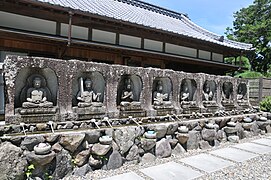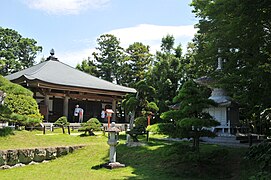Kanjizai-ji
The Kanjizai-ji ( Japanese 観 自在 寺 ), with the Go Heijōzan (平城 山) and Yakushiin (薬 師院) in Minamiuwa County (南 宇 和 郡), Ehime Prefecture , is a temple of the Daigakuji branch (大 覚 寺 派) of the Shingon Buddhism . In the traditional count it is the 40th temple on the Shikoku pilgrimage route . The Kanjizai-ji is the temple that is furthest from Temple No. 1 and is therefore also called the "turning point of the consecrated places of Shikoku " (四 国 霊 場 の 裏 関 所, Shikoku reijō no ura-sekisho). It is also the first temple in Ehime Prefecture when walking clockwise on the pilgrimage route.
history
According to tradition, in 807, at the request of Emperor Heizei , Priest Kūkai made the main cult figure, a Yakushi Nyōrai and as a companion an Amida Nyōrai and an eleven-faced Kannon from a piece of wood from a sacred tree (霊 木, Reiboku) and a complete temple complex (七 堂伽藍, shichdō garan).
In 1638, Prince Kūshōhosshinnō (空 性 法 親王) from Daikaku-ji in Kyōto visited the temple on a pilgrimage and stayed overnight. The go “Yakushiin” comes from him. At the time, the temple was flourishing, with 48 clusters and an income of over 2,000 koku . All buildings were lost in fires in the Edo period , but some of them could be rebuilt with the support of the princes of Uwajima, a branch of the Date , for whom the Kannjizai-ji was the prayer temple.
investment
You enter the temple via a staircase and pass the temple gate, which is designed here as a Niō gate (仁王 門; 1), as a gate with space for the two temple guards to the right and left of the passage. On the right hand you have the temple bell (鐘楼, Shōrō; 2), after a few steps you can also see the octagonal pavilion "Hōjuden" (宝 聚 殿 八角 堂; 3) on the right. After a few steps you pass an elongated, low building on the left (; 4), which shows twelve Buddhist saints as stone sculptures on its front.
After a little way and a few steps you stand in front of the main hall (Hondō; 5). It burned down in 1959, but was renewed until 1964. To the right is the Daishidō (大師 堂; 6), the hall dedicated to the temple founder. It was rebuilt in 1993 in the pyramid style (宝 形 造 り, Hōjei-zukuri) and, as a special feature, is surrounded by a corridor that is sprinkled with sand. In front of the Daishidō there is a stone treasure pagoda on the green, here called "Shinkeihōtō" (心 経 宝塔; 7). The last pavilion is the one for the holy Sasayama Daigongen (篠 山大 権 現; 8).
The guest house (信 従 会館; Shinjū Kaikan; G) of the temple can be reached directly from the street.
photos
literature
- Ehime-ken kotogakko chireki komin bukai rekishi bukai (Ed.): Kanjizai-ji . In: Ehime-ken no rekishi sampo. Yamakawa Shuppan, 2008. ISBN 978-4-634-24638-6 . Page 222, 223.
- Oguri, Doei: Kukai. Shikoku hachijuhachi kosho no arukikata. Chukei no Bunko, 2011, ISBN 978-4-8061-4067-2 .
Web links
Coordinates: 32 ° 57 '52.8 " N , 132 ° 33' 50.6" E







